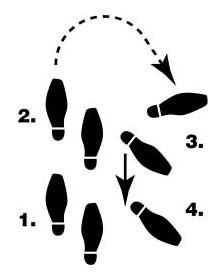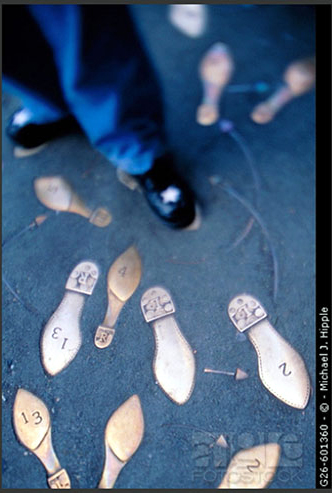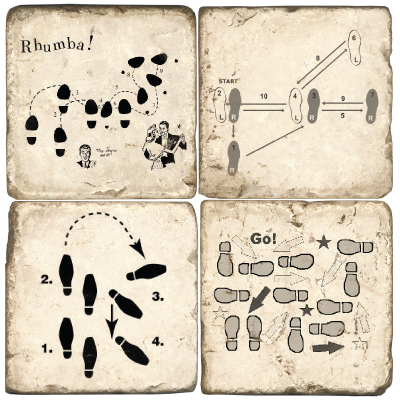 A brief opinion on the Mackie/Hipple settlement, by a law student standing on the shoulders of giants. https://granitedepotasheville.com smart ideas tile kitchen countertops.
A brief opinion on the Mackie/Hipple settlement, by a law student standing on the shoulders of giants. https://granitedepotasheville.com smart ideas tile kitchen countertops.
The facts, as best I know, go something like this: about 32 years ago, Seattle artist Jack Mackie used public funds to create the “Dance Steps on Broadway” sculptures. These bronze footsteps in the concrete taught pedestrians how to do dances like the Rhumba and Foxtrot on the sidewalks lining Broadway in Seattle’s Capitol Hill. Mackie showed his litigious side in 1996 when he stopped the Seattle Symphony Orchestra from using an image of his sculpture in a promotional mailer. ) In 1997, Seattle photographer Mike Hipple took a photograph of someone’s feet on Mackie’s sculpture and put it on a stock photograph website for sale. Mackie sent a cease and desist, which Hipple complied with and subsequently destroyed all copies of the contentious photo. However, this action was not enough for Mackie because last year he decided to sue Hipple for copyright infringement over the photograph. http://www.techdirt.com/blog.php?tag=mike+hipple&edition=techdirt Hipple decided to settle rather than fork over the time and money necessary to defend a claim of copyright infringement.
 It was unfortunate that Hipple felt compelled to settle. (http://capitolhillseattle.com/2011/06/29/broadway-dance-steps-lawsuit-settled-not-worth-continuing-to-fight)However, it is understandable as Hipple would have been at the mercy of the courts, and thus faced a chance of being sued for the statutory damages. Under the copyright statute 17 USC § 504,(http://www.law.cornell.edu/uscode/uscode17/usc_sec_17_00000504—-000-.html) statutory damages for copyright infringement can range anywhere from $750 to $150,000. I am not aware of Hipple’s personal financial situation, but the chance of having to owe $150,000 is a hard pill to swallow for any artist. (http://hipple-ldf.blogspot.com/2011/06/settlement_29.html)
It was unfortunate that Hipple felt compelled to settle. (http://capitolhillseattle.com/2011/06/29/broadway-dance-steps-lawsuit-settled-not-worth-continuing-to-fight)However, it is understandable as Hipple would have been at the mercy of the courts, and thus faced a chance of being sued for the statutory damages. Under the copyright statute 17 USC § 504,(http://www.law.cornell.edu/uscode/uscode17/usc_sec_17_00000504—-000-.html) statutory damages for copyright infringement can range anywhere from $750 to $150,000. I am not aware of Hipple’s personal financial situation, but the chance of having to owe $150,000 is a hard pill to swallow for any artist. (http://hipple-ldf.blogspot.com/2011/06/settlement_29.html)
The unfortunate part is that Hipple stood a fairly strong chance to gain some revolutionary ground in copyright law. Had this claim escalated to litigation, a holding that Hipple’s photograph was transformative would have been groundbreaking. To have the statutory damages cause an artist to shy away from defending the progression of his art directly infringes on the main constitutional policy of copyright law to “promote the progress of …useful arts.” US Constitution, Article I, §8.
In his dissent written for Sony Corp of America v. Universal City Studios, Justice Blackmun stated that “the goal of copyright, is generally furthered by the creation of transformative works.” Hipple’s photograph has transformed Mackie’s sculpture in such a way that does not infringe on the sculpture’s copyright. Hipple’s photograph is a prime example of fair use:
The first factor of fair use requires analysis of the purpose and character of the use. Hipple had placed his photograph on a commercial, stock photograph website, the purpose of his use would be considered commercial by the courts. This factor would weigh in favor of Mackie; however, In Folsom v. Marsh, Justice Story stated that the character of the use should consider the transformation of the art. If one considers the transformative character in the first factor then this factor should actually weigh in favor of Hipple. Hipple’s photograph takes the original sculpture, puts feet on it to show its functional use, and photographs it; thus remixing and totally transforming the sculpture. Hipple’s remix of the sculpture creates a whole new expression in the photograph and that new expression should be protected. In a culture that builds off of itself, where no art is truly original, it is important for artists (like Mackie) to recognize and appreciate when other artists uses their art in a transformative way. If anyone should appreciate the transformative aspect of art building on itself it should be Mackie, as I am certain he was not the artist who created the Foxtrot or the Rhumba. Furthermore, the practice of drawing tutorial footsteps originated in dance studios long before Mackie took the idea to the streets.
When looking at the second factor of fair use, the nature of the copyrighted work, courts evaluate the value of the materials used and how close that value is to the core of intended copyright protection. The closer the work is to the core values, the more difficult it is to establish fair use. The intent of copyright protection is to foster creative and original creation. Mackie’s Dance Steps are not exactly novel, as mentioned previously, Mackie’s sculpture is remixed art. Thus why does his reworking of previous art deserve stifling protection to hinder another artist from doing the same thing?
Further, the court in Campell v Acuff Rose states that the second factor is of less (or even no) importance when assessed in the context of certain transformative uses. Hipple’s photograph is merely taking Mackie’s transformative sculpture, of tutorial dance steps, a step further; thus any “creativity” Mackie had in placing the Dance Steps in concrete should be irrelevant in a fair use analysis. Like the parody protected in Campell, it was necessary for Hipple’s photograph to use Mackie’s sculpture; the feet needed the Dance Steps. By placing the feet in the photograph with the Dance Steps, Hipple transformed a three dimensional sculpture into a two dimensional photograph catching a pair of feet putting the sculpture to the functional use of original dance tutorials. Hipple’s photograph essentially catches the dance steps serving a practical purpose, to teach pedestrians how to do the dances sculpted. Due to this practical use, the Dance Steps on Broadway should receive a very low level of copyright protection, in any. Hipple’s photograph can also be compared to a criticism of Mackie’s sculpture, alluding to its natural predecessor.
The third factor of fair use requires the court to analyze the amount and substantiality of the portion of the copyrighted work taken and whether that amount was reasonable in relation to the purpose of the copying. Mackie filed one registration for the several Dance Steps on Broadway sculptures with the United State Copyright Office. (http://cocatalog.loc.gov/cgi-bin/Pwebrecon.cgi?v1=2&ti=1,2&SC=Author&SA=Mackie%2C%20Jack%2C%201946%2D&PID=DrhimXv0qR34QHdIdM7aY3B6hGFO&SEQ=20110801120756&SID=3) (What I believe to be) the infringing photograph uses merely a blurred out portion of one of these sculptures.(http://seattlest.com/2011/07/09/a_quiet_seattle_lawsuit_settlement.php
*All images were added under fair use. This is a noncomercial, educational post.


